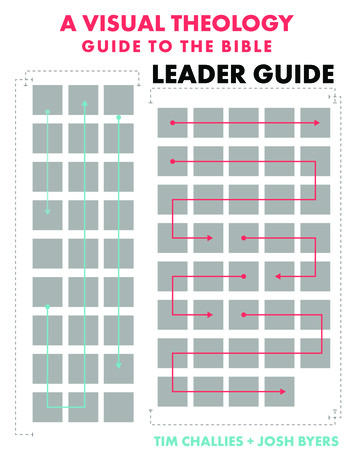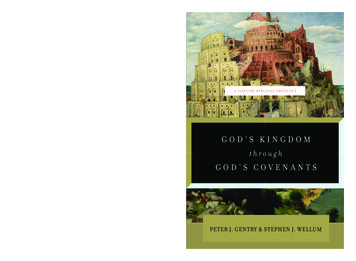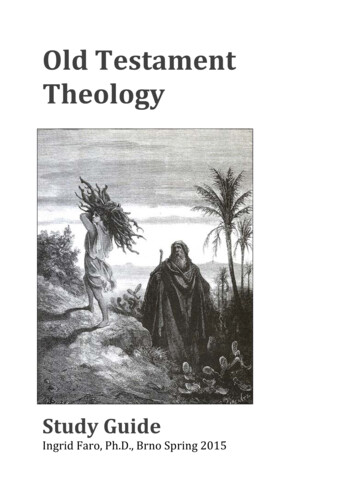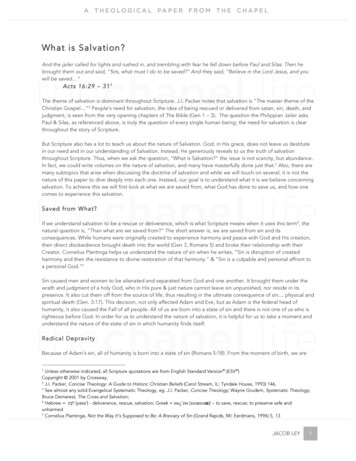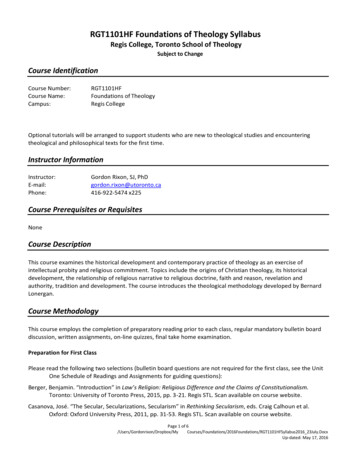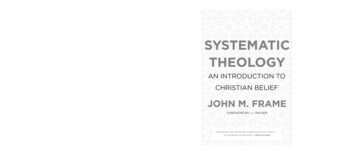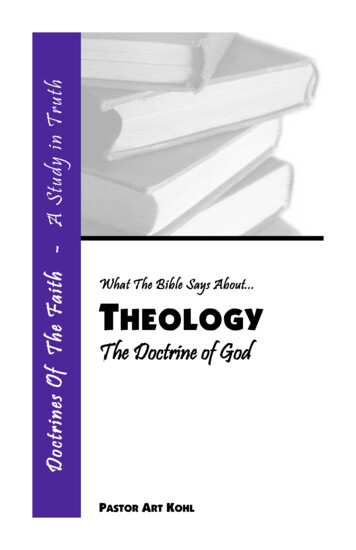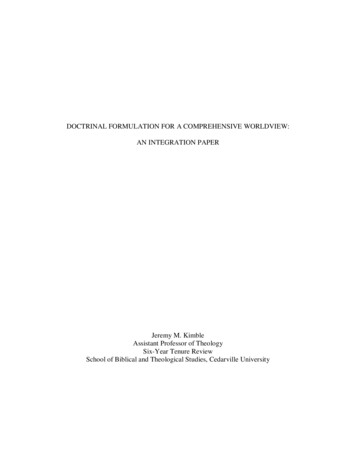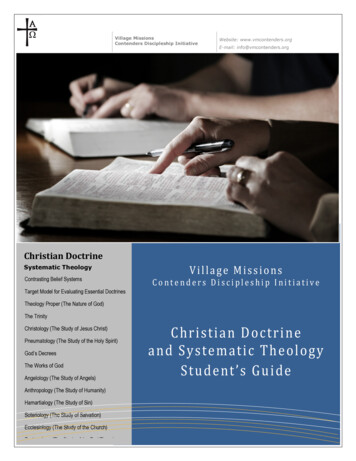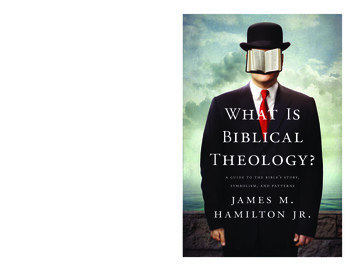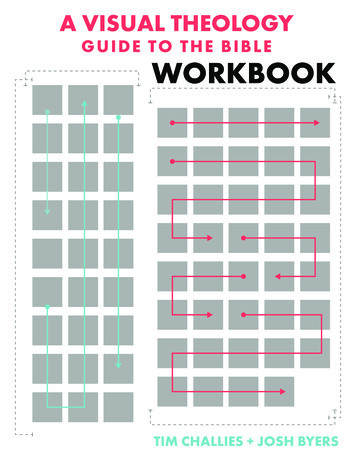
Transcription
LICENSINGBONUS CONTENT LICENSEIf you received this workbook as part of the bonus content with the purchase of the bookA Visual Theology Guide to the Bible you must abide by the following terms:YOU MAY: Print one copy of the workbook for personal or organizational use.Transfer the workbook file to another computer, hard drive, flash drive, etc. as long as the workbook file remains in useon one and only one drive at any given time during the duration of the license. You may store a copy in the cloud forbackup purposes.YOU MAY NOT: Use or display the Content for any for-profit “on demand” products, including but not limited to art prints, posters,postcards, mugs, t-shirts, hoodies, laptop cases/skins, phone cases/skins, tote bags, rugs, or other products (includingbut not limited to website services such as cafepress.com, zazzle.com, society6.com, etc.).Duplicate/copy the Content files on to any secondary computer, hard drive, flash drive, etc. except for backuppurposes.Freely share or sell the Content files with other individuals or organizations or post them to a peer-to-peer sharing site.Use the images in any posters (printed on paper, canvas or any other material) or other items for resale, license or otherdistribution for profit.MEMBER & GROUP LICENSEIf you purchased a Visual Theology Membership or a Group Download from the Visual Theology website youmust abide by the following terms:YOU MAY: Print up to 5,000 copies for use in advertising and promotional applications for your church, ministry organization,Bible study, or classroom, including presentation sideshows, printed materials, not-for-profit product packaging, filmand video, brochures and promotional postcards at no charge (not for resale or license).Use the images in online publications (including web pages, blog posts, and email newsletters) to a maximum of 1200pixels wide.Use the designs to make prints, posters, and other reproductions for strictly personal use or promotional purposesspecified in above (see bullet point #1), but not under any circumstances for resale, license or other distribution forprofit and not to exceed 5,000 copies.YOU MAY NOT: Use or display the Content for any for-profit “on demand” products, including but not limited to art prints, posters,postcards, mugs, t-shirts, hoodies, laptop cases/skins, phone cases/skins, tote bags, rugs, or other products (includingbut not limited to website services such as cafepress.com, zazzle.com, society6.com, etc.).Duplicate/copy the Content files on to any secondary computer, hard drive, flash drive, etc.Freely share or sell the Content files with other individuals or organizations or post them to a peer-to-peer sharing site.Use the images in any posters (printed on paper, canvas or any other material) or other items for resale, license or otherdistribution for profit.A VISUAL THEOLOGY GUIDE TO THE BIBLE WORKBOOKCopyright 2019 by Tim Challies & Josh Byers. All rights reserved.Scripture quotations are from The Holy Bible, English Standard Version (ESV ), copyright 2001 byCrossway, a publishing ministry of Good News Publishers. Used by permission. All rights reserved.3A VISUAL THEOLOGY GUIDE TO THE BIBLE WORKBOOOK
HOW TO USE THIS WORKBOOKThank you for reading A Visual Theology Guide to the Bible. It is a tremendous honor for us to be able to createresources like this one, knowing they will be used around the world to teach the truth about God and his Word.WHAT IS THE PURPOSE?The purpose of this workbook is to enhance and direct your attention to key concepts laid out in A VisualTheology Guide to the Bible. The blanks we’ve provided are not arbitrary. Rather, every one has been carefullyselected to point out the big ideas we want you to know and the important terms we want you to remember.WHO IS IT FOR?This workbook can be used by individuals who are reading through the book on their own and wish to use aresource to help them understand and remember it.The workbook is also extremely useful in a classroom or small group setting where a teacher is leading studentsthrough the material. In this context, it will keep students engaged with the content and help them identify andretain key ideas.HOW IS IT USED BEST?While the workbook is useful for individuals, it was originally made for use in a classroom setting. We alsocreated accompanying presentation slides that perfectly pair with it, making it ideally suited to a teacher who isleading his or her class through A Visual Theology Guide to the Bible. (Visit visualtheology.church to learn moreabout the slides.)It’s our prayer that A Visual Theology Guide to the Bible and this workbook will be a blessing to you and to yourstudents as together you see the beauty of God’s Word in a new and exciting way.Sincerely,Josh & TimFOLLOW US FOR ALL THE LATEST UPDATES ON NEW POSTERS, DOWNLOADS AND MORE!@VISUALTHEOLOGY4VISUALTHEOLOGY.CHURCHA VISUAL THEOLOGY GUIDE TO THE BIBLE WORKBOOOK@VISUALTHEOLOGY
INTRODUCTIONTo Christians, the Bible is , God’s message to the world.It unveils the , reveals the , describes the, and calls the reader to .THE BIBLE TELLS US: we are, why we why we are so , how we are to to God, and how everything will someday be made .THE BIBLE MAKES MONUMENTAL CLAIMS ABOUT ITSELF.It describes itself as to guide the lost,to revive the sick,wisdom to correct the ,inspiration to the sorrowful,to heal the blind.It insists it is more valuable than and sweeter than .It declares it is able to teach and correct error, that it will guide us away from unethicalbehavior and toward behavior that and others.5A VISUAL THEOLOGY GUIDE TO THE BIBLE WORKBOOOKINTRODUCTION
CHAPTER ONE: WHAT IS THE BIBLE?Employing the word “bible” represents a claim of .A bible is an authoritative source of or .The word “bible” is derived from the ancient Greek , which refers not to a particular book, butto the papyrus used to create an early form of paper.WHAT IS THE STRUCTURE OF THE BIBLE?The Bible is much like any other book in that it has internal cohesion. From beginning to end, it provides apicture of who is, who are, and what we need most.TESTAMENTSIts broadest structure is a division into “testaments,” the Old Testament and the New Testament. Theword we translate as “testament” could more accurately be translated as so when wespeak of Old Testament and New Testament, we are really speaking of Old Covenant and New Covenant.A covenant is an between two parties that governs the terms of their relationship. The OldTestament details the establishment of the Old Covenant and the promises of the Christ, and theNew Testament describes the of the New Covenant that God had planned all along.BOOKSThere are books in the Old Testament and in the New Testament for a total of 66.The Old Testament books tell of the creation of the world, the founding of the Israelites, the establishment of thosepeople in the promised land, their special relationship with God, their disobedience to God, and their resultingcaptivity by hostile nations.A constant theme is the of a Messiah who will fully and finally liberate the Israelites fromdanger and oppression.6A VISUAL THEOLOGY GUIDE TO THE BIBLE WORKBOOOKCHAPTER ONE
The New Testament books tell of the birth, life, and death of Jesus; they tell of the work of the earliest Christians tospread their message; they instruct Christians in how to live and tell how God intends to bring history to its close.A recurring theme is that Jesus is the who was in the Old Testament.NAMESEach of the books in the Bible has a name.They are often named after the of the book or after one of its key .Sometimes books are given a name that their content.CHAPTERS & VERSESBooks are divided into chapters and chapters are divided into verses. These divisions were presentwhen the books were written but were added much later to assist with finding a specific place within the Bible.GENRESbooks are meant to describe historical events as they happened in the past.Examples include Genesis, Ruth, and Acts.books tell how God intends the ancient nation of Israel to function religiously, politically, andsocially. Examples include Leviticus and Deuteronomy.books are collections of aphorisms and wise sayings meant to guide the relationship to God andto one another. Examples include Job, Proverbs, and Ecclesiastes.books are poetic forms of praise to God or gratitude for his gifts to humanity. Examples includePsalms, Song of Solomon, and Lamentations.7A VISUAL THEOLOGY GUIDE TO THE BIBLE WORKBOOOKCHAPTER ONE
books are predictions of future events and warnings to be prepared for them. They are at timeshopeful, predicting an outpouring of God’s blessings and at times dreadful, predicting all manner of woe. Examplesinclude Isaiah, Jeremiah, and Revelation.are short biographies of Jesus. There are four of them, each written by a different author andfor a different purpose: Matthew, Mark, Luke, and John.are letters that usually have a section dedicated to teaching truth about God and a sectiondedicated to telling people how to live in light of that truth. Examples include Galatians, 1 Thessalonians, and 1Peter.writings are a specific form of prophecy predicting disaster and destruction. Examples includeDaniel and Revelation.WHAT IS THE PURPOSE OF THE BIBLE?“Nearly all the wisdom we possess, that is to say, true and sound wisdom, consists of two parts: the knowledge ofGod and of ourselves.” - John CalvinThe Bible exists to impart true and sound from God toThe purpose of the Bible is to mankind who God is and his plan to mankind fromtheir sin through his Son, Jesus Christ.The Bible is God’s gift to you— collection, testaments, books written,collected, and preserved —so that you might know him and his salvation in Jesus Christ.8A VISUAL THEOLOGY GUIDE TO THE BIBLE WORKBOOOKCHAPTER ONE
QUESTIONS FOR FURTHER STUDY1.Many books have the word “bible” in the title (e.g., Jeep Owner’s Bible). List a few things, from chapter one,that makes the Bible different than these other books.2. In your own words, describe the purpose of the Bible.3.Review the list of genres on pg. 20.How might the various genres impact the way you read different books of the Bible?4.When you study the info-graph on pg. 22-23, it’s clear that the Bible is an incredible book. What stands outto you the most as you review these pages?9A VISUAL THEOLOGY GUIDE TO THE BIBLE WORKBOOOKCHAPTER ONE
NOTES
NOTES
CHAPTER TWO: HOW WAS THE BIBLE WRITTEN?THE BIBLE WAS GOD-BREATHED“All Scripture is breathed out by God and profitable for teaching, for reproof, for correction, and for training in righteousness ”2 Timothy 3:16This beautiful imagery shows that all of the holy Scriptures (graphē) are out by God, so thatevery word comes from his .THE BIBLE WAS HUMANLY COMMUNICATEDWhile the Bible is from God, it is for humans. God breathed out his Word to communicate with us. This means thatGod chose words in human language as his primary way of speaking to us.The Bible was written in two primary languages, and , and onesecondary language, Aramaic.While Hebrew was a language used mostly by the people of , Greek was the languagefor people. As God extended his covenant promises to all nations and commanded his peopleto proclaim good news to the ends of the earth, the language of his written word shifted to accommodate thistransition.THE BIBLE WAS CAREFULLY PRESERVEDWhile recent scholarship has questioned the preservation of the original manuscripts of the Bible, the truth is that theBible has evidence for its integrity than any other ancient book.Recent archaeological findings confirm the of the Bible we have in our possession.THE PRESERVATION OF THE OLD TESTAMENTWhat is the significance of this? It serves as just one of many evidences that over the course of many centuries, theHebrew text was preserved. Because of the similarities in the manuscript, we can be thatthe Old Testament we have today is an extremely copy of the original Hebrew Scriptures.12A VISUAL THEOLOGY GUIDE TO THE BIBLE WORKBOOOKCHAPTER TWO
THE PRESERVATION OF THE NEW TESTAMENTWhile the manuscript evidence for the Old Testament is encouraging, the manuscript evidence of the NewTestament is by any other ancient book. There are more than Greek manuscriptscontaining either parts or all of the New Testament text. Compare this to Homer’s Iliad, which only hasmanuscripts in existence, or Beowulf, which comes to us from only manuscript.FROM GOD TO YOUWhile thousands of years have passed since God breathed out the Old and New Testament Scriptures, theyremain the living, Word of God today. Though the Scriptures have passed through countlessscribes and many forms—from papyrus to paper to phone—you can be that the Word youread today is the very Word that was breathed out by God and written by the prophets and apostles.13A VISUAL THEOLOGY GUIDE TO THE BIBLE WORKBOOOKCHAPTER TWO
QUESTIONS FOR FURTHER STUDY1.How do you most often read the Bible (i.e., physical copy or electronic copy)?What are the advantages or disadvantages of each?2. We understand from 2 Timothy 3:16 that the Bible is inspired (i.e., God-breathed).Describe the difference between the inspiration of the Bible and the inspiration for a country song.3.Is there anything new that you learned in chapter two? Explain.4.Study the infograph on pg. 32-34.How does this information strengthen your trust in the reliability of the Bible?14A VISUAL THEOLOGY GUIDE TO THE BIBLE WORKBOOOKCHAPTER TWO
NOTES
NOTES
CHAPTER 3: HOW WERE THE BOOKS COLLECTED?The Bible is a collection. Not a single word is , and not a single word can be. Every book that should be in the Bible is already there, and we can be confident that thereis no unknown book that will be added. The Bible will never be released in an updated and revised version. TheBible we hold is and .The books of the Bible are not a handpicked by the church.Instead, the books of the Bible are God’s written Word, which were recognized by the church as such. That’swhy it’s not quite accurate to say that the books of the Bible were “chosen” or selected by a church council. Moreaccurately, we should say they were “ ” Over time, God’s peoplethe books that were written by God and the books that weren’t.The collection of writings that have been recognized are called .F. F. Bruce defines the term in this way: “The Canon of Scripture . . . is the list of writings delivered to us as thedivinely inspired record of God’s self-revelation to men—that self-revelation of which Jesus Christ our Lord is thecentre.”Although many factors affected why certain books made it into the canon, the primary question was whetherGod had and the book.If it wasn’t God, then it couldn’t be a part of God’s WordTHE CANON OF THE OLD TESTAMENTBy the time of Jesus, there was widespread about the canon of Old Testament.The canon . God himself wrote the Ten Commandments on tablets of stone for Mosesand the people of Israel:“The tablets were the work of God; the writing was the writing of God, engraved on the tablets.” Exodus 32:16Then I turned and came down from the mountain and put the tablets in the ark that I had made. And there they are, as the LORDcommanded me. Deuteronomy 10:517A VISUAL THEOLOGY GUIDE TO THE BIBLE WORKBOOOKCHAPTER THREE
Moses’s successor, Joshua, the practice of writing down words “in the Book ofthe Law of God.”And Joshua wrote these words in the Book of the Law of God. And he took a large stone and set it up there under the terebinththat was by the sanctuary of the LORD. Joshua 24:26After Joshua, a succession of other men of God, most of whom were prophets, recorded the words of God, tellingof God’s great acts and his covenant promises to his people. The people of God thatthese holy writings were God’s words, just as God had told the prophet Jeremiah:Thus says the LORD, the God of Israel: Write in a book all the words that I have spoken to you. Jeremiah 30:2Since 475 BC, nearly twenty-five hundred years ago, the books within the Old Testament canon have.The Old Testament Scriptures were written with the that they were God’s holy Word, andthey have been understood in this way.THE CANON OF THE NEW TESTAMENTWhen the Spirit of truth comes, he will guide you into all the truth, for he will not speak on his own authority, but whatever hehears he will speak, and he will declare to you the things that are to come. John 16:13The writings of the disciples show that they understood their work to be the of Jesus’ promise.They were God’s words with God’s .If anyone thinks that he is a prophet, or spiritual, he should acknowledge that the things I am writing to you are a command of theLord. 1 Corinthians 14:37And count the patience of our Lord as salvation, just as our beloved brother Paul also wrote to you according to the wisdomgiven him, as he does in all his letters when he speaks in them of these matters. There are some things in them that are hard tounderstand, which the ignorant and unstable twist to their own destruction, as they do the other Scriptures. 2 Peter 3:15-16Jesus’ promise to guide the apostles’ teaching provided the foundational litmus test for the New Testament canon:works by or authorized by an were accepted.The inclusion of Hebrews in the canon demonstrates the second criterion for inclusion: there needed to bea general consensus or by the church that the book was God’s Word. If it was not inwidespread use across the churches, it could not be recognized as Scripture.18A VISUAL THEOLOGY GUIDE TO THE BIBLE WORKBOOOKCHAPTER THREE
Besides being authored or authorized by an apostle and receiving general recognition from the church, the bookalso with other Scriptures. Because God never lies or contradicts himself, God’sWord itself.All of the books in both the Old and New Testament are time-tested, doctrinally sound, and divinely inspired. Wethat all of the books in the Bible belong.Long ago, at many times and in many ways, God spoke to our fathers by the prophets, but in these last days he has spoken to usby his Son, whom he appointed the heir of all things, through whom also he created the world. Hebrews 1:1-2CAN ANY OTHER BOOKS BE ADDED?The author divides God’s spoken revelation into two eras: andwhich is the era spanning from Jesus’ ascension to Jesus’ second coming. Once,God spoke through his , but now, in the last days, he speaks by the .Until that day when we see God face-to-face, there is Scripture to be added.WHAT ABOUT THOSE OTHER BOOKS?If you flip open a Roman Catholic Bible, you may notice several extra books that aren’t included in the Protestantcanon. These are called the and they were written during the period between Malachi andthe coming of Christ (approximately 475 BC–AD 30). They include books like Tobit, Judith, Sirach, and 1 and2 Maccabees.Jesus and his disciples quote the Old Testament Scriptures as divinely authoritative almost three hundred times, butthey the Apocrypha as divinely authoritative.While Jerome added the Apocrypha to the Latin Vulgate, he made it clear that they were “books of the church”and as equal to the Scriptures. The Roman Catholic Church, however,increasingly relied on the Apocrypha until the Council of Trent in 1546, when they officially declared theApocrypha to be a part of the canon. The Reformers, in contrast, returned to the traditional view of theApocrypha as for the church but of the canon.19A VISUAL THEOLOGY GUIDE TO THE BIBLE WORKBOOOKCHAPTER THREE
QUESTIONS FOR FURTHER STUDY1.We live in a world where things are continually changing and being updated.Why is it so important that the Bible never changes?2. The word “canon” refers to the books of the Bible recognized by the church as inspired (i.e., God-breathed).In your own words, describe how this is different than choosing, which books are in the Bible(hint: See page 36).3.How do we know that the canon is complete (i.e., no Scripture will be added)?In what ways does this increase your confidence in the Bible?20A VISUAL THEOLOGY GUIDE TO THE BIBLE WORKBOOOKCHAPTER THREE
NOTES
NOTES
4 A VISUAL THEOLOGY GUIDE TO THE BIBLE WORBOOO Thank you for reading A Visual Theology Guide to the Bible.It is a tremendous honor for us to be able to create resources like this one, knowing they will be used ar
